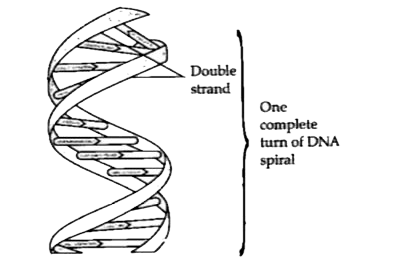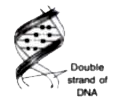In the double helix structure of DNA, the base pairs are
part of the backbone structure
inside the helix
outside the helix
Bonded with covalent bond
The correct Answer is:B
To solve the question regarding the location of base pairs in the double helix structure of DNA, we can follow these steps:
1. Understanding the Structure of DNA:
- DNA has a double helix structure composed of two strands that run in opposite directions.
- Each strand is made up of a sugar-phosphate backbone and nitrogenous bases.
2. Identifying the Components:
- The nitrogenous bases in DNA include adenine (A), thymine (T), guanine (G), and cytosine (C).
- These bases pair specifically: adenine pairs with thymine (A-T) and guanine pairs with cytosine (G-C).
3. Locating the Base Pairs:
- The base pairs are formed between the two strands of DNA through hydrogen bonds.
- These pairs are located in the center of the double helix, between the two sugar-phosphate backbones.
4. Analyzing the Options:
- Option A: Part of the backbone structure - This is incorrect because the backbone consists of sugar and phosphate, not the bases.
- Option B: Inside the helix - This is correct as the base pairs are located in the center of the double helix.
- Option C: Outside the helix - This is incorrect because the bases are not located outside; they are protected within the helix.
- Option D: Bonded with covalent bond - This is incorrect because the base pairs are held together by hydrogen bonds, not covalent bonds.
5. Conclusion:
- Based on the analysis, the correct answer is Option B: inside the helix.
- DNA has a double helix structure composed of two strands that run in opposite directions.
- Each strand is made up of a sugar-phosphate backbone and nitrogenous bases.
- The nitrogenous bases in DNA include adenine (A), thymine (T), guanine (G), and cytosine (C).
- These bases pair specifically: adenine pairs with thymine (A-T) and guanine pairs with cytosine (G-C).
- The base pairs are formed between the two strands of DNA through hydrogen bonds.
- These pairs are located in the center of the double helix, between the two sugar-phosphate backbones.
- Option A: Part of the backbone structure - This is incorrect because the backbone consists of sugar and phosphate, not the bases.
- Option B: Inside the helix - This is correct as the base pairs are located in the center of the double helix.
- Option C: Outside the helix - This is incorrect because the bases are not located outside; they are protected within the helix.
- Option D: Bonded with covalent bond - This is incorrect because the base pairs are held together by hydrogen bonds, not covalent bonds.
- Based on the analysis, the correct answer is Option B: inside the helix.
Topper's Solved these Questions
- BIOMOLECULESBook:AAKASH INSTITUTE ENGLISHChapter:BIOMOLECULESExercise:Objective type question(Objective Type Questions (One option is correct))
Explore 5 Videos
- BIOMOLECULESBook:AAKASH INSTITUTE ENGLISHChapter:BIOMOLECULESExercise:Section-B (Objective Type Questions (One option is correct))
Explore 11 Videos
- BIOMOLECULESBook:AAKASH INSTITUTE ENGLISHChapter:BIOMOLECULESExercise:Try yourself
Explore 17 Videos
- AMINES Book:AAKASH INSTITUTE ENGLISHChapter:AMINES Exercise:Assignment Section -J (Aakash Challengers Questions)
Explore 9 Videos
- CHEMICAL BONDING AND MOLECULAR STRUCTURE Book:AAKASH INSTITUTE ENGLISHChapter:CHEMICAL BONDING AND MOLECULAR STRUCTURE Exercise:Assignment Section J (Aakash Challengers Questions)
Explore 10 Videos
Similar Questions
Given below is a diagram of the double helical structure of DNA.

Who gave the double helical model to explain the structure of DNA ?
View SolutionThe reason for double helical structure of DNA is the operation of:
View SolutionIn the double helix modle of DNA , how far is each base pair from the next base pair
View SolutionWho gave the double strand helix structure of DNA?
View SolutionAssertion: The two strands in double strand helix structure of DNA are complementary to each other
Reason: Disulphide bonds are formed between SQPecific pairs of bases
View SolutionChoose the set of correct statements for hydrogen bonding between complimentary bases of double helix structure of DNA.
a. Responsible for parallel nature of the two DNA strands.
Maintains stability of double helix.
Generates approximately uniform distance between the two strands.
View SolutionGiven below is a diagram of a double helical structure of DNA.

Name the four nitrogenous bases that form a DNA molecule.
View SolutionList the salient features of double helix structure of DNA.
View SolutionWhich is not consistent with double helical structure of DNA?
View SolutionIn double helix of DNA, the two DNA strands are
View Solution